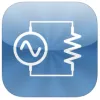Take a look inside 5 images
iCircuit
Pros: Tons of options for building circuits, from using basic parts like wires, batteries, and switches to employing more complex parts like transformers, diodes, and accelerometers.
Cons: Circuit components and features aren't organized by level of difficulty.
Bottom Line: This is a thorough virtual tool for building and simulating circuits, but it would benefit from some integrated instruction and help buttons.
If you are teaching a unit about circuits and electricity to upper level or advanced students, then iCircuit would be great to use as a virtual lab. You could spend at least one class period reviewing the User Manual with students as they follow along on their devices in small groups. Then have them work in their groups to build circuits and measure current and voltage. You can give students a specific list of components to use in their circuits, or challenge them to build a specific type of circuit and leave it up to them to choose the components. Have students print their circuits and get together with another group to compare diagrams.
iCircuit is a virtual tool that lets kids build and test circuits. Kids can also explore 13 examples of circuits by tapping on different components to view details about voltage and current. To get started, kids tap the "New Circuit" button, which takes them to a main grid. Kids drag and drop the components they want to use onto the grid and use a touch and drag feature to draw wires. The more than 30 components include voltage sources, current sources, switches, buzzers, photoresistors, inductors, capacitators, and LEDs. After they build their circuits, kids can use a multimeter to probe the circuit and read currents and voltages. A built-in oscilloscope lets kids observe changes in voltages over time. Kids can duplicate, share, and print diagrams of their circuits if desired.
Kids can learn about circuits and the flow of electricity through experimentation. As they drag and drop components, draw wires, and connect the parts, kids can see their circuits in action because the program is a continuous simulation, as if the power were really on. This makes analysis of the circuits extremely user friendly. Another nice feature is that kids can set the properties of their components. For example, kids can set a resistance for resistors or they can set a current gain for transistors. Once their circuits are complete, kids can select a component and analyze it using the built-in multimeter. This allows kids to see voltage and current readings as the virtual electricity flows through the circuit. Kids can also use the built-in oscillator to monitor component properties over time.
Learning through experimentation is extremely important in science, and iCircuit certainly supports this type of learning. But it's important to note that most of the features are very complex, even for high school kids. Sure, you can instruct kids to only use the basic components and to build a simple circuit, but the true value of the app is that users can simulate highly complex circuits. The User Manual does a fantastic job of explaining all of the features, but kids can't access hints or instructions directly from the app. Therefore, kids with a background in electrical engineering would get the most bang for the buck.













